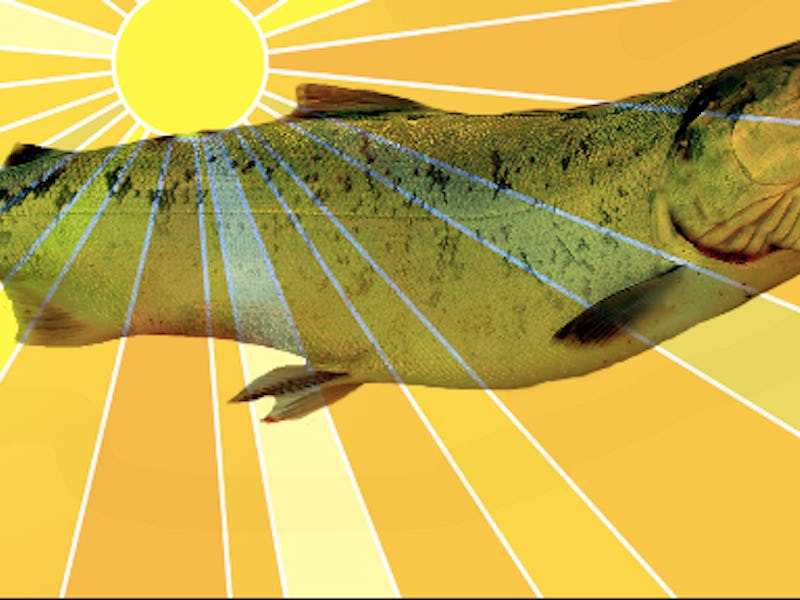In the Future, You'll Slather On Salmon Sperm Sunscreen
It's where DNA meets Vitamin D.

A team of biomedical engineers have come up with a surprising new way to celebrate summer safely: slathering your skin in a layer of DNA derived from salmon sperm.
In research published in the journal Scientific Reports, scientists from Binghampton University — SUNY detail how they created the salmon sperm sunscreen using optically transparent crystalline DNA films capable of protecting skin from ultraviolet light. When they irradiated the DNA films with UV light they found that the more UV they blasted, the better the films became at absorbing it. That means that theoretically, a person wearing these films would be more protected from the sun the longer they stayed out on the beach.
The scientists created these DNA films by coating the sides of a glass vial with Deoxyribonucleic acid sodium salt taken from salmon sperm, wetting that DNA with pure ethanol, then agitated the DNA with deionized water until it became homogenous — meaning that the molecular makeup of the DNA samples became the same. Apart from the DNA, the film is comprised of sub micrometer crystals — so DNA crystals are what eventually reduces the UV light.
Tanning, which happens when ultraviolet radiation from the sun enters your skin cells and mutates your DNA, makes some humans bronzed, and others lobstery. Regardless, not having a barrier between UV rays and your skin can cause serious damage to mitochondrial and genomic DNA, leading to a sunburn, aging, and even cancer.
Close-ups of the DNA crystals hit with UV light.
That’s where sunscreen enters, which usually has a time limit to its efficacy and strength. But salmon sperm sunscreen has no such time limit, which means the longer you frolicked on the beach, the more protected you would be.
Lead author Guy German, PhD, explains to Inverse that the primary reason salmon sperm was used was because of its “availability from scientific suppliers and low cost.” Affordability is key if this is ever going to be a product people can eventually buy.
“From a fundamental level, we hope our work will help to improve our understand of how light interacts with, and can alter, self-assembled DNA structures,” says German. “But also, yes, we hope to utilize DNA in a diverse range of applications for mainstream use.”
While these DNA films may eventually be a sunscreen alternative, German and his team also believe they could be effectively used as wound coverings. That’s because the DNA films are hygroscopic — when applied to human skin, they keep the tissue hydrated for long periods of time. This suggests to the researchers that the coatings could not only protect wounds from the sun, they’d also keep them moist which helps injuries heal faster. The added bonus is that they’re clear, meaning that doctors could check in on the healing process without removing the treatment.
Abstract: We report on ultraviolet (UV) light induced increases in the UV optical density of thin and optically transparent crystalline DNA films formed through self assembly. The films are comprised of closely packed, multi-faceted and sub micron sized crystals. UV-Vis spectrophotometry reveals that DNA films with surface densities up to 0.031 mg/mm2 can reduce the transmittance of incident UVC and UVB light by up to 90%, and UVA transmittance by up to 20%. Subsequent and independent film irradiation with either UVA or UVB dosages upwards of 80 J/cm2 both reduce UV transmittance, with reductions scaling monotonically with UV dosage. To date the induction of a hyperchromic effect has been demonstrated using heat, pH, high salt mediums, and high energy ionising radiation. Both hyperchromicity and increased light scattering could account for the increased film optical density after UV irradiation. Additional characterisation of the films reveal they are highly absorbent and hygroscopic. When coated on human skin, they are capable of slowing water evaporation and keeping the tissue hydrated for extended periods of time.